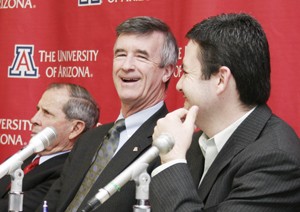In the wake of economic turmoil, both nationally and within the state of Arizona, tuition costs and budget cuts have been a near yearly occasion. The UA, along with sister schools Arizona State University and Northern Arizona University, will face a definite increase in tuition over the next fiscal year.
The Arizona Board of Regents hosted a tuition hearing Monday night in order to discuss the issues derived from an increased tuition, which was broadcast at the UA, as well as ASU and NAU and all related branches of each university.
Although an exact raise in tuition has not yet been set for the UA, President Robert Shelton has given recommendations, which, according to Shelton, will be finalized on Dec. 4 in Phoenix.
“”I realize these are challenging times for the state, for our supporters and for our students,”” Shelton said. “”Sadly, the fiscal reality of our current economic environment requires us to invest increases in tuition resources into the quality of the education we provide.””
According to figures presented by the board of regents, current tuition for resident undergraduate students on the main campus is $5,531 per academic year, but will be increased by 12.8 percent to $6,237 per
academic year. For non-resident
students, the percentage
increase is even greater, at 14 percent, which will increase the average from $18,665 to $21,287 per academic year. For graduate students, the increase is relatively similar, from an
average $6,321 to $7,027 for residents, and $18,958 to $21,580 for non-residents.
The proposed increase in
tuition reflects growing numbers of graduate and undergraduate debt, according to the board. Within the last 10 years, graduate student debt has increased from just less than 30 percent upon graduation in 1997-98, to more than 50 percent in 2007-2008. In 1997-98, the average amount of debt for graduate students was between $25,000 and $30,000, but last year the average debt upon graduation was just under $35,000.
Although undergraduates have on average less debt upon graduation than graduate students, the percentage of undergraduates graduating with debt was generally higher, from more than 40 percent in 1997-98 to more than 50 percent in 2007-2008.
These figures were met with much care by Shelton, who said he understood the fine line that must be walked between
driving students away with cost of tuition and rates of debt, and attracting students with a higher quality of education.
“”I remind everyone that
lower price tuition is not the same thing as an affordable education,”” Shelton said. “”Given the choice between permanent cuts in academics or increased tuition … we choose the latter.””
During the hearing, each university was represented by their respective president, their student body president, students from both main campuses and outlying ones and a member of the board of regents. Each university alternated representation, which created a time constraint that did not allow for debate or responses.
Of the plans surrounding tuition raise, three points were highlighted as primary efforts and concerns of the Arizona Students’ Association: affordability, accountability and predictability. These concerns were raised to ensure that quality of education is properly balanced with cost of tuition, and in a manner that benefited students.
Tommy Bruce, president of the Associated Students of the University of Arizona, stressed the importance of these proposals, specifically accountability, as a method which will allow student input and determination in a factor which heavily influences them.
“”Nobody knows the student experience better than students,”” Bruce said. “”It is our goal and our proposal to say that a portion of all tuition revenues is … put into student-determined priority.””
Accountability, which detailed the importance of student response, was the focus of much student reaction.
“”Students are the best people to know at the universities, to know what is really the focus, what areas are lacking right now and how we can reinvest in our university,”” said Michael Slugocki, ASA board chair.
In addition to accountability, affordability was another source of anxiety for students, who were as concerned with quality of education as they were with the ability to
afford it.
“”I disagree,”” said Billy Holmes, economics sophomore, in regards to the universities’ affordability. “”Each year tuition increases, I wonder how am I going to graduate; also, I want to go to law school, but I don’t see how I am going to afford that. These are major concerns.””
The board of regents will be accepting letters from students regarding the tuition increase in order for the board and the UA to meet fiscal demands by raising tuition, but not without sacrificing the attraction for students or the quality of education, Shelton said.









